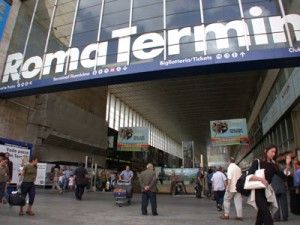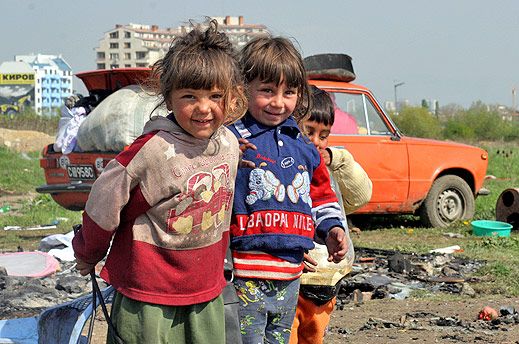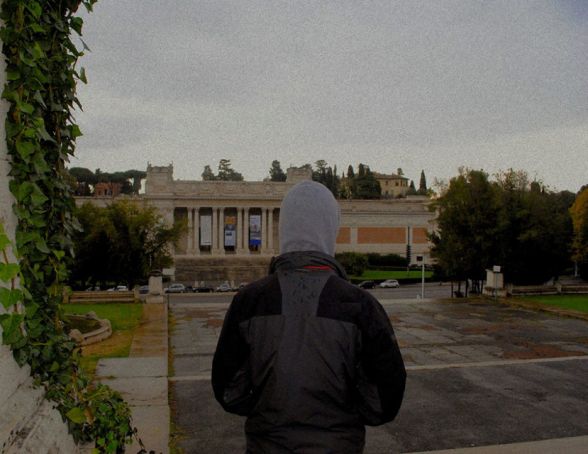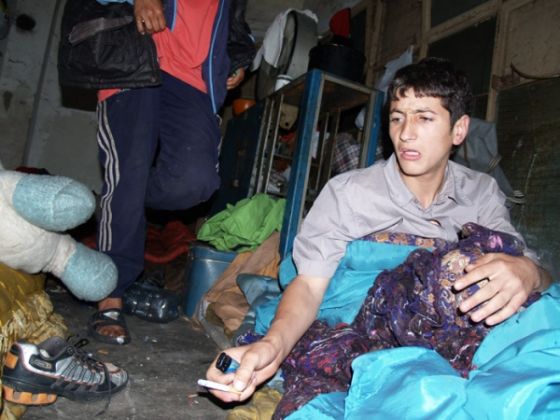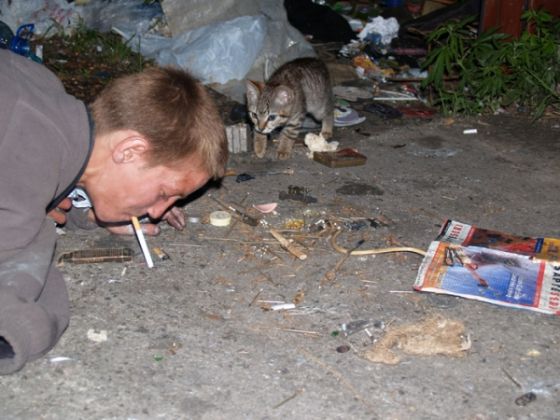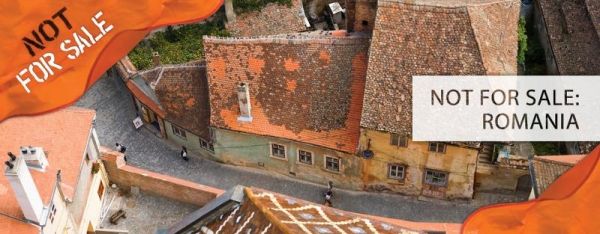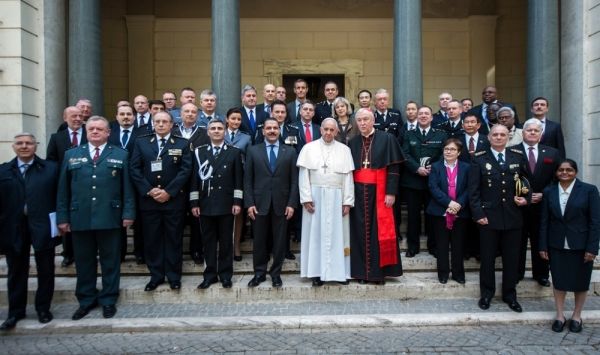Romanian orphans come of age on the streets of Italy
TERMINI STATION. While commuters are rushing towards their trains, youths circle around the escalator to Via Giolitti. They wear tight jeans and tough-looking jackets. Some are small boys, others young adults. They all try to make eye contact – their stares hard and aggressive. One of them hisses at me. Meanwhile, fashionably-clad adults and old men stand in a circle around the boys observing them. What is going on? One of the boys leaves the station. He walks towards Piazza della Repubblica. On the piazza, he joins two other boys at the fountain beside the kiosks. The last tourists are leaving. A car stops. One of the boys approaches it. After a short conversation, he gets in. By the time the last store closes, more boys have gathered and several men are roaming the square.
A man follows a small boy. One after another they disappear between two kiosks. “Scusa, una sigaretta?” a shortish and skinny boy asks just outside McDonald’s. He is smiling. His name is Mirko and he is from Romania. About 40 Romanian boys work here at night. More than half of the city’s unaccompanied minors are Romanian.
When Ceaușescu fell, he left 700 state-run orphanages hiding 170,000 neglected orphans. Poverty and a ban on contraception and abortion had made parents cede their children to the state. The country lacked food and often the orphans were fed intravenously. The nurses, however, had to reuse injection needles: 15 per cent of the toddlers became HIV infected. They were called the “incurables”. Many of the orphanages still operate.
Child traffickers circle around them like wolves looking for lost sheep. “Trenta euro. Faccio di tutto,” Mirko whispers. “What?” He explains: “I am only active, of course.” “Active?” “That’s what you want, isn’t it?” He smiles. “Don’t worry: I’m marvellous.” “Thirty euro?” “Twenty then. Or a Big Mac, please,” he begs. “Food, cigarettes, a new pair of jeans and I’ll stay the weekend at your place.” I am baffled. “Are you homeless? Or do you live in the camps? Are you a gypsy?” Mirko wearies. “Ricchione!” he yells. “Mine is bigger than yours!” He then turns and walks off.
MIDNIGHT. VALLE GIULIA. The broad and leafy avenues are dead silent. Between the dim lamps, darkness reigns over the valley. Motorcycles stand before murky meadows; the headlights of parked cars shine in sinister squares. I explore the alley behind the Museum of Modern Art where once boys as young as 13 years used to work. The only person I see is an old man who is leaving an apartment building. Dressed immaculately and with thick white hair, he looks quite distinguished. He must be at least 60.
At the top of steps at the front of the museum I spot a boy. He is smoking a cigarette. Every time a car passes, he stares at it. I take a place at a couple of metres from him. “Are we the only ones working tonight?” I ask. “No,” he says, “there’s another one.” He points downwards, at a Mediterranean-looking boy who seems to be waiting at the bus stop.
A man appears at the bottom of the steps. He turns in circles for a while and then walks up. Though the boy is smoking, the man asks me for a cigarette. I tell him I am sorry and give him a smile. He hesitates. For a second I think he wants to say something, but he just walks on.
A few minutes later, another boy joins us. He starts talking to the boy next to me. They are speaking Romanian.* A car enters the square, circles round twice and stops at a distance. Its headlights switch off. From behind the steering wheel, a middle-aged man with a heavy beard and thick glasses gazes at me. Suddenly a Fiat Panda crosses the square. Not even a minute later, the Panda reappears. It approaches me and slows down. It’s the distinguished man I crossed behind the museum. The driver also recognises me. He turns his head, accelerates and rushes off.
“Sei nuovo, vero?” shouts the boy who arrived last. “What?” I ask. “You must be new. They like new faces.” I join the boys. “Hey, I’m Mike.” “I’m Adrian,” he says. “And this is George.” George’s phone goes. He takes it and walks towards the trees. When he comes back he says it was a regular, and that he’ll have a place to stay the night. George boasts he charges clients a €750 affitto: the money it takes to rent a boy for the weekend.
Another car pulls up. The driver signs for George to walk over to him. George drops his cigarette, dims it with his right foot and walks to the car. He chats with the driver and gets in. The car drives to the adjacent square. Less than 15 minutes later, George returns. He is all smiles and waves with two €50 bills. He says something to Adrian. I catch “married”, “minor” and “police”.
These boys, knowing their clients lead a double life and will never denounce them, turn to blackmail and robbery. They are without identity and move from one city to another. Raised in orphanages by indifferent nurses, the boys have never known affection. Many suffer from mental distortions. Too much intimacy – a misplaced gentle touch, a declaration of love – often ends in blood. I say goodbye to the boys and leave. At the bottom of the steps the boy at the bus stop has been witnessing the scene. In perfect Italian he says: “These Romanians are washed-up after some time on the streets.” No, they were washed up long ago.
*According to research presented to the Diplomatic Academy of Vienna, 58 per cent of the Romanian minors trafficked abroad are in Italy. Figures from the Romanian National Agency against Trafficking of Persons show the top destinations outside Romanian itself are Italy and Spain.
Mike Dilien
This article first appeared in the June edition of Wanted in Rome
SIDE NOTES
Data on human trafficking
One of the difficulties in the fight against human trafficking is organising reliable data. The information available is not always correlated in the same way, for example it is not always uniformly reported as to whether trafficking is for labour exploitation, for sex or for other reasons (such as organs), nor is the information always divided by gender and age. Reporting periods are also different. In the EU, police forces are still the main source of information. And although it is probable that data on prosecution and convictions of traffickers is reasonably reliable because it comes from official judicial documents, data on victims can only be assumed to be the tip of the iceberg.
There are a large number of NGOs in every country working with the victims (37 in Germany alone) and it is highly unlikely that all their information is reported to state authorities. The difference in the figures for the countries listed below reflects not only the differences in reporting methods but also national differences in policies and priorities on human trafficking.
UNITED NATIONS DATA
One of the most complete sources of information is the Global Report on Trafficking in Persons 2012 by the United Nations Office on Drugs and Crime. Trafficking of people has not been recognised as a particular sort of worldwide crime until recently and therefore it still comes under the UN office on drugs and crime rather than a separate department of its own.
Below we list the comparative figures for Italy, Romania and the United Kingdom in the 2012 UN report.
ITALY
Traffickers: In 2007 there were 622 arrests, 461 prosecutions and 80 convictions. In 2010 there were 509 arrests, 361 prosecutions and 99 convictions.
Victims: In 2007 there were 715 reported victims, mainly for sexual exploitation. In 2010 there were 328 reported victims, mainly for sexual exploitation.
Nationality of victims 2007-2010: Romania 427, Nigerians 383, Italians 176, Bulgaria 116, Chinese 51, others 186.
ROMANIA
Traffickers: In 2007 there were 429 prosecutions with 188 convictions. In 2010 there were 415 prosecutions with 276 convictions.
Victims: In 2007 there were 1,714 reported victims. In 2010 there were 1,154 reported victims.
Nationality of victims: About half the victims were trafficked for labour and half for sex. Most of the victims in Romania were Romanian nationals.
UNITED KINGDOM
Traffickers: In 2007 there were 27 prosecutions and 23 convictions. In 2010 there were 30 prosecutions and 16 convictions.
Victims: In 2009 there were 549 reported victims. in 2010 there were 712 reported victims.
Nationality of victims: In 2009 the nationalities of 214 of the victims were unknown, 98 were from Nigeria and 72 from China. In 2010 the nationalities of 316 victims were unknown, 122 were from Nigeria and 79 from China.
EUROPEAN UNION DATA
The European Union has recently set up its own directives against people-trafficking and the EU statistical organisation Eurostat issued its first report in 2013, using data from 2008, 2009 and 2010. It was only in 2012 that the EU selected human trafficking as one of its priority areas in its fight against organised crime. Traffickers: Prosecution of traffickers. The report indicates that traffickers within the EU were mainly EU nationals (67 per cent in 2008 rising to 76 per cent in 2010). Convictions of traffickers: These decreased 13 per cent in the three year period. Victims: According to the Eurostat data, 62 per cent of victims within the EU were trafficked for sexual exploitation (rather than for labour or for organs) and that the majority (61 per cent) of the identified victims were from EU member states. Nationality of victims: Most victims throughout the EU were from Romania and Bulgaria. Victims from outside the EU were mainly from Nigeria and China.
Reports consulted:
United Nations Office on Drugs and Crime. Global Report on Trafficking in Persons 2012.
The European Commission Eurostat Trafficking in human beings 2013.


